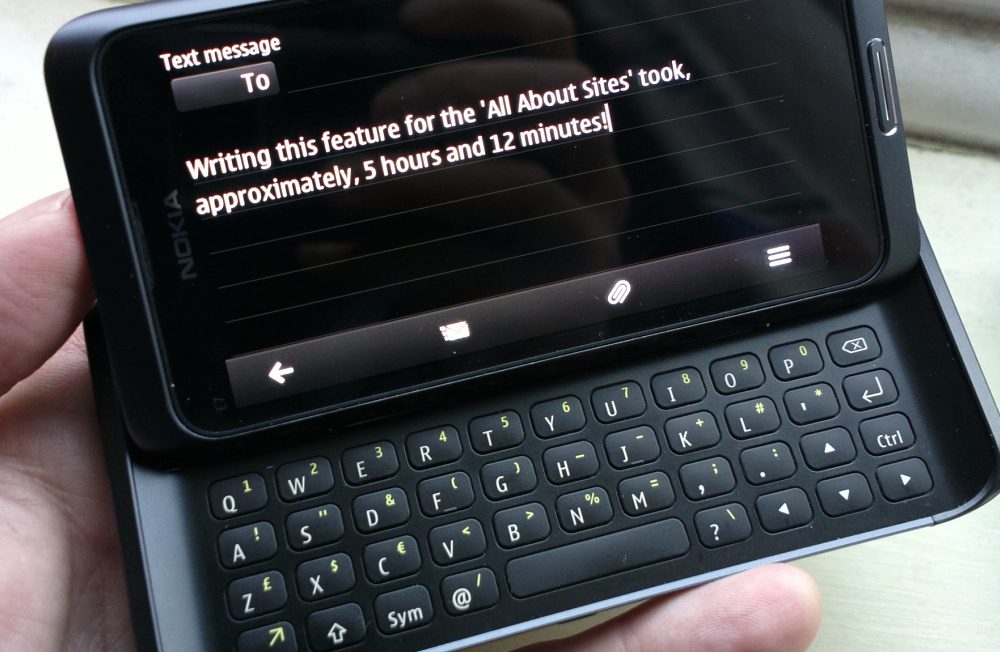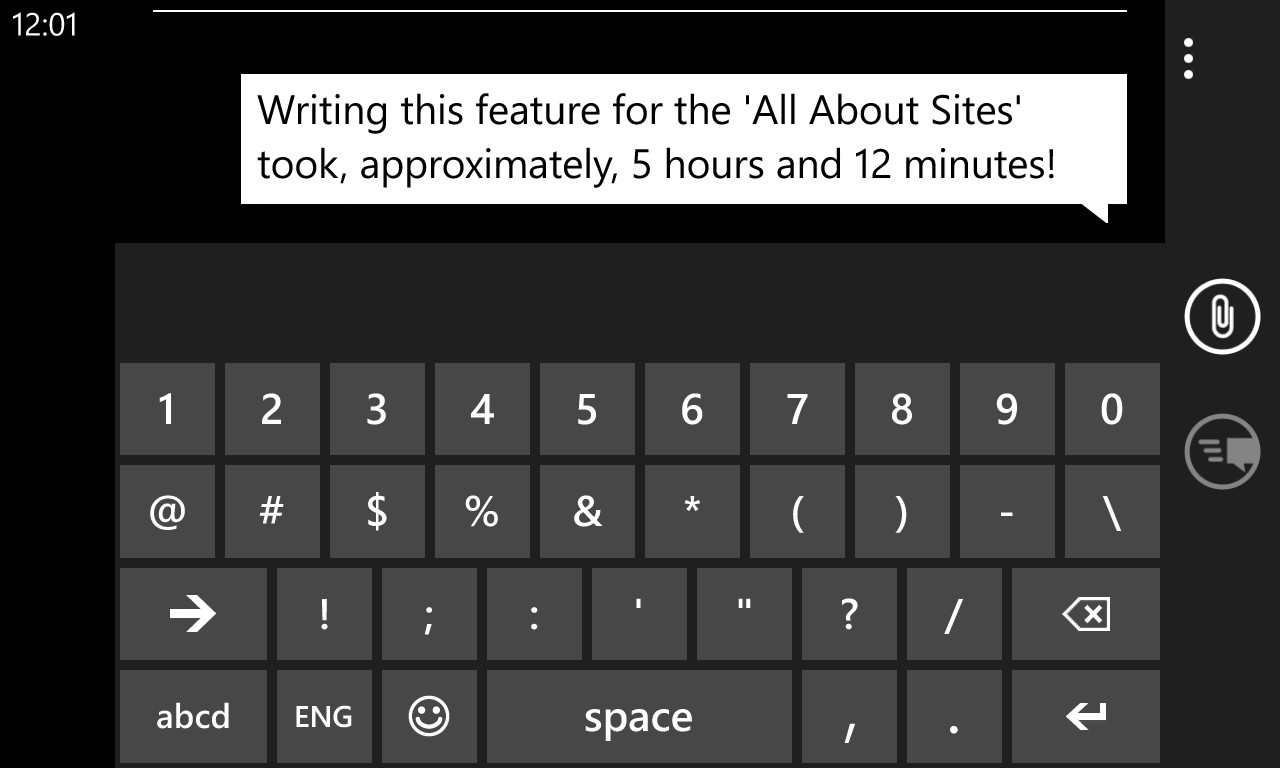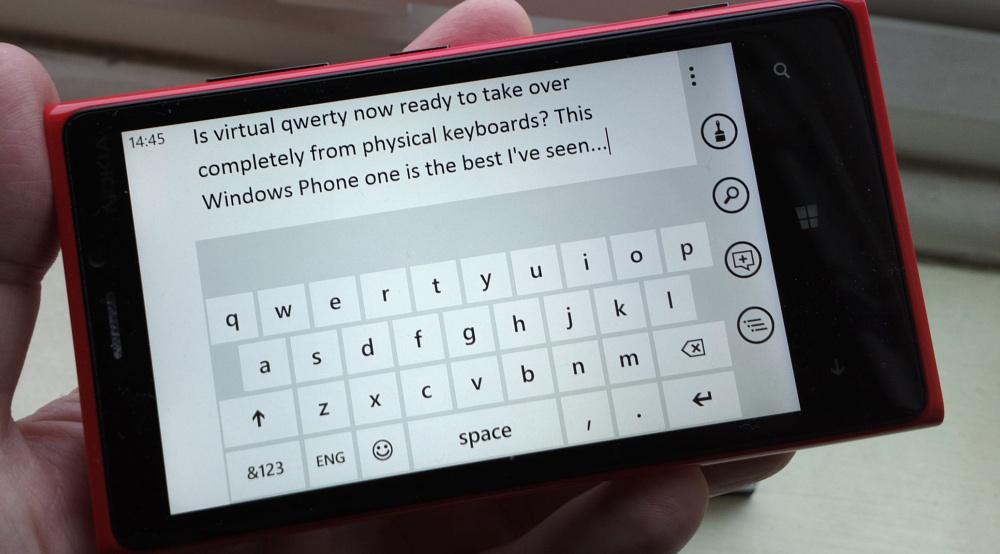
Now, obviously, my methodology here will have to involve some compromises:
- Devising a test sentence involves making decisions about what the average user might want to enter (letters, numbers, punctuation, message length, etc.) - I've tried to pick a representative test text that's not too long, not too short and uses a variety of real world characters.
- My own past history with using smartphones might introduce some bias in terms of performance. So I practised the test sentence numerous times using each method before timing them in action. I.e. I tried not to let my own clumsiness get in the way of fast input! And then I took my fastest time for each. In other words, I wanted to see how fast each method could go.
- Allowing for the fact that I'm not going to be perfect at each text input method, I'll allow up to one mistake without having to use extra time to go back and correct it. After all, in the real world, you'd often leave a single wrong character in a text message rather than go back and be grammatically perfect every time.
The test sentence used was "Writing this feature for the 'All About Sites' took, approximately, 5 hours and 12 minutes!" - so a mix of capitalisation, some numbers, some punctuation, and not too long or short. Testing a short sentence would be unrepresentative of people wanting to write longer pieces, while testing a long paragraph would be unrepresentative of people who only really enter short texts and email responses.
The two metrics considered were speed (i.e. how long it took to get the text in) and how accurate it was (after the allowed one mistake). The first is in seconds, with quicker being better, obviously, and the second is a rating from 1 to 10, in my opinion, after several input attempts and plenty of practise. I then divide the first number into the second and multiply by 100, to get an overall score, so that I can rank the systems.
The various options for text input being considered, and their results, were:
- Swype input (on Android, tested here on the Galaxy Nexus, but also available in slightly limited form on Symbian) - my fastest time for the test sentence was 42 seconds. I tried in both portrait and landscape modes, by the way. Quality was pretty good, though stopping for punctuation seemed more forced than when pecking out letters individually. Even my best attempt had a strange typo at the end, as shown, though doubtless even more practice could have eliminated that. Rating 8.

- Voice input (on iOS or Android, tested here on the Galaxy Nexus) - my fastest time for the test sentence was 18 seconds. Quality was low, even my best attempt had half a dozen things that needed editing, from typos to missing punctuation. Rating 4.

- Virtual QWERTY input (on all platforms, here tested on the Nokia Lumia 920's 4.5" screen in landscape mode, with text writing aids about as good as they come) - my fastest time for the test sentence was 36 seconds. Quality was excellent, with no mistakes whatsoever on the 4th attempt (shown below). Rating 9.

- Full size QWERTY physical input (on the Nokia E7, an almost unique form factor these days) - my fastest time for the test sentence was 37 seconds. Quality was excellent, with no typos whatsoever on my second attempt. Rating 10.

- Thumb-size QWERTY input (on the Nokia E6, a form factor shared now only by Blackberry models and a few very low end Androids and feature phones) - my fastest time for the test sentence was 39 seconds. Quality was pretty good, adding the apostrophe and capitalising the site name was a little fiddly on the small keyboard, and with only one comma missing on my best try. After most of the other input systems in the test, this seemed cramped and slightly awkward, interestingly! Rating 8.

- T9 predictive input (on the Nokia 808 with its optional number pad input turned on) - my fastest time for the test sentence was 63 seconds. Quality wasn't perfect, since the implementation on Belle FP2 really didn't like me adding apostrophed sections, plus the capitalisation didn't work and there was a stray space. Rating: 5.
Doing the calculations, then, (rating/speed)*100, gives a ranking table:
- Full size QWERTY: 27
- Virtual QWERTY: 25
- Voice input: 22
- Thumb-size QWERTY: 20
- Swype: 19
- T9: 8
I suppose it should come as no surprise that, when a mix of words, punctuation and numbers are involved, a real QWERTY keyboard of sufficient size proves top dog, though it's significant that a good 'virtual' equivalent is only marginally behind the best physical implementation. In other words, a user of, for example, a Nokia E7, can rightly claim to be able to bash out text for emails, texts and reports faster than anyone on any other smartphone, yet someone proficient on a decent virtual keyboard won't be far behind and won't have to live with the bulk of the physical keys day in and day out.
I'm still a fan of physical QWERTY keys (of good size, as on the E7 - or HTC 7 Pro, for example), and I found myself significantly more relaxed when faced with hammering out the test sentence including punctuation, than I did when attempting it and relying more on writing aids and pop-up punctuation. But I'll acknowledge that real world results are now such that such a physical keyboard isn't as essential as it once was.
Voice input remains disappointing. Perhaps my voice isn't 'American' enough, I did have numerous tries and Android's recognition just couldn't get the hang of me saying 'comma'. Voice is fine for getting something down very quickly, far faster than any other system, but there's always so much to edit and tidy afterwards if you want to present text that's close to what you intended.
Thumb QWERTY was powerful but as fiddly as usual on the tiny Nokia E6 keyboard. I did also try my Blackberry Bold 9900 but have never got on with the slanted keys and wasn't any faster. Even with average sized thumbs, typing something complicated, with punctuation and numbers is a bit of a rigmarole on a keyboard of this size. Of course, the same applies to some degree to virtual keyboards in portrait mode on most phones, which is why I was using landscape mode for the virtual input above.
The speed of Swype was interesting. No doubt I'll get slammed by the Swype-loving brigade for simply not being 'good enough at it', but I spent more tries at the test sentence with Swype than any other system here. When simply entering words, Swype is as effective and as fast as typing letter by letter, perhaps even more so, but it's a slight mental switch out of 'swyping' mode to enter punctuation and special characters and this slowed things down. Plus words like 'approximately' above are just horrendous to trace out. I still maintain, and this is just my personal opinion, that, overall, Swype involves more finger or thumb motion than two-thumb pecking and is therefore more tiring and, for real world text with punctuation, will take slightly longer on average.
T9/predictive is looking a bit sad in this test, but it should be borne in mind that it was designed for physical keypads, not the somewhat quirky implementation in software on (for example) Symbian, where it's now a deprecated option. I suspect that I could shave 50% off my time with it on a great physical number keypad, as on the Nokia N86 or any of a number of good tradition 'phones'. Even with a 50% bump, this option would still end up last though, emphasising that the other input systems on trial are, at the end of the day, simply superior.
____________

I think we can assume that voice recognition will continue improving, maybe to the point where it can equal the best virtual input methods. I do think we're a year or two away from this happening though. The disappearance of physical keyboards from smartphone form factors across the world is a trend I've noted before, somewhat sadly(!), but my own test numbers somewhat back this up - after all, if you can get nearly as good text input on a touch display without the bulk, complexity and expense of a full keyboard then why not dispense with the latter completely?
Look at the photo above - I tried to go as fast as I possibly could and some of the words were a complete mish mash of right and wrong letters, yet the recognition software nailed it. I was gob smacked - virtual input has come such a long way.
Comments welcome, unless you want to abuse me for my lack of Swype skill, in which case send your comments to clumsy-fingers@swype.bitbucket....
